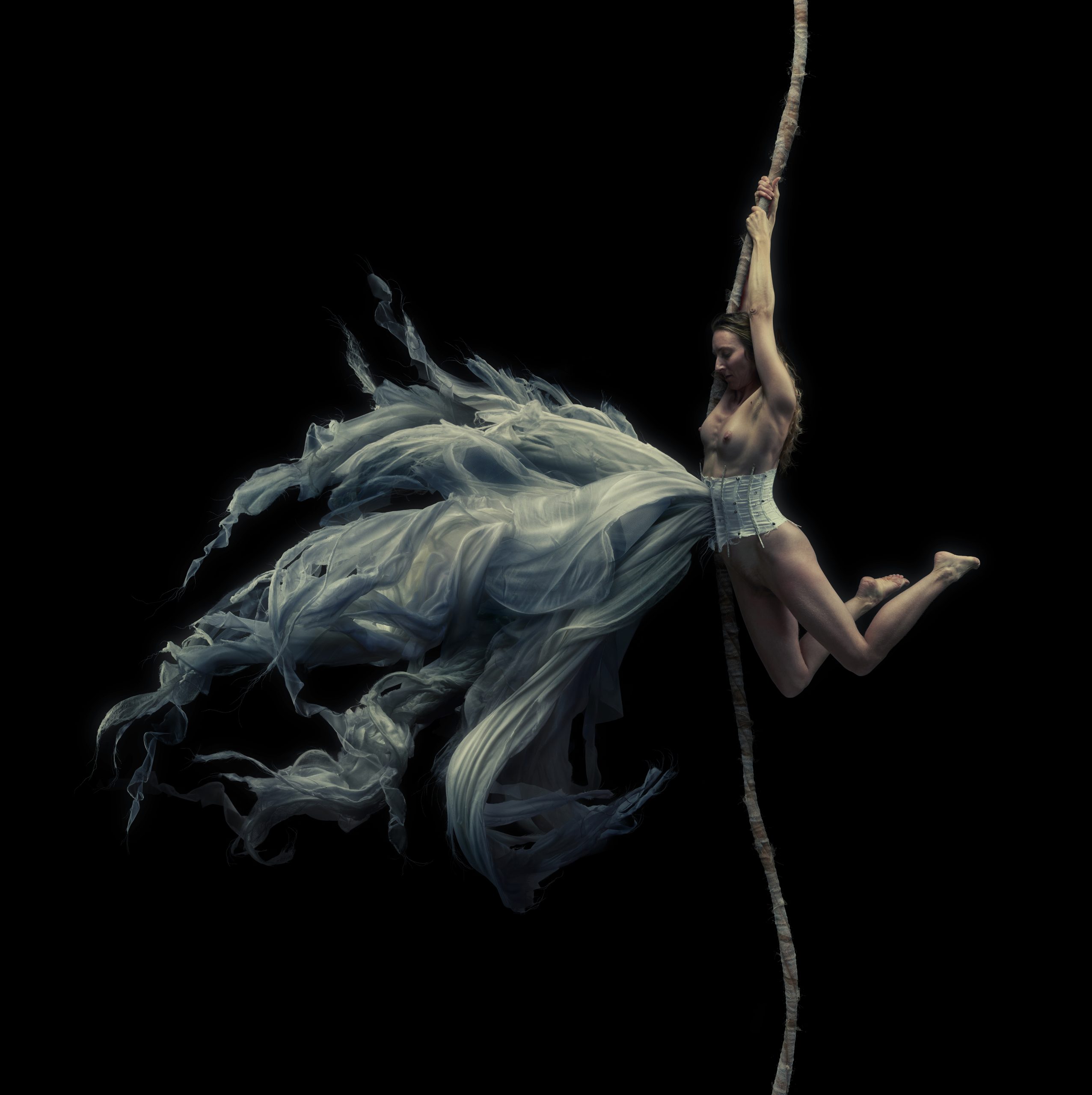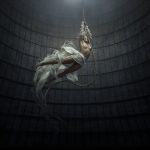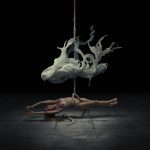-

Balancing Act
These photographs depict the human body in a state of ambiguity. Hanging on rope-like structures, the figures engage in acts of athleticism, endurance and performance. Yet they are also in a precarious position, vulnerable, exposed, and forced to manoeuvre in unconventional ways. They exist in a limited and challenging space that renders them as spectacle, perpetually the subject of scrutiny and othering, suggestive of women’s restricted power in society. The figures are enveloped by an industrial building; a toxic, contaminated and outmoded structure, a symbol of patriarchal power.
The ropes they cling to have a fleshy materiality. These corporeal lines serve as the only point of contact between the figures and their surroundings. Reminiscent of an umbilical cord, they suggest a kind of somatic link to the world, extending the body’s boundaries.
The figures are swathed in fabrics that are akin to some sort of elaborate medical dressing, indicating a pathologization of the female form. Bandages seek to enclose and regulate form, but these bodies spill out, exploding beyond their dressings and cannot be contained.
External forces seek to impose a conforming order but the body and the self are defined by their fluidity and malleability, not by a fixed identity. They are, like the photographs in which they are represented, revealed not to be a source of truth and stability, but instead an illusion masking a shifting and uncertain reality.
Caught between movement and stillness, identity and dissolution, the figures in these photographs are suspended in a liminal and indeterminate zone. Whilst appearing to defy gravity, they are actually tethered to a fixed line; neither safely grounded, nor flying free.
-

Balancing Act
These photographs depict the human body in a state of ambiguity. Hanging on rope-like structures, the figures engage in acts of athleticism, endurance and performance. Yet they are also in a precarious position, vulnerable, exposed, and forced to manoeuvre in unconventional ways. They exist in a limited and challenging space that renders them as spectacle, perpetually the subject of scrutiny and othering, suggestive of women’s restricted power in society. The figures are enveloped by an industrial building; a toxic, contaminated and outmoded structure, a symbol of patriarchal power.
The ropes they cling to have a fleshy materiality. These corporeal lines serve as the only point of contact between the figures and their surroundings. Reminiscent of an umbilical cord, they suggest a kind of somatic link to the world, extending the body’s boundaries.
The figures are swathed in fabrics that are akin to some sort of elaborate medical dressing, indicating a pathologization of the female form. Bandages seek to enclose and regulate form, but these bodies spill out, exploding beyond their dressings and cannot be contained.
External forces seek to impose a conforming order but the body and the self are defined by their fluidity and malleability, not by a fixed identity. They are, like the photographs in which they are represented, revealed not to be a source of truth and stability, but instead an illusion masking a shifting and uncertain reality.
Caught between movement and stillness, identity and dissolution, the figures in these photographs are suspended in a liminal and indeterminate zone. Whilst appearing to defy gravity, they are actually tethered to a fixed line; neither safely grounded, nor flying free.
-

Balancing Act
These photographs depict the human body in a state of ambiguity. Hanging on rope-like structures, the figures engage in acts of athleticism, endurance and performance. Yet they are also in a precarious position, vulnerable, exposed, and forced to manoeuvre in unconventional ways. They exist in a limited and challenging space that renders them as spectacle, perpetually the subject of scrutiny and othering, suggestive of women’s restricted power in society. The figures are enveloped by an industrial building; a toxic, contaminated and outmoded structure, a symbol of patriarchal power.
The ropes they cling to have a fleshy materiality. These corporeal lines serve as the only point of contact between the figures and their surroundings. Reminiscent of an umbilical cord, they suggest a kind of somatic link to the world, extending the body’s boundaries.
The figures are swathed in fabrics that are akin to some sort of elaborate medical dressing, indicating a pathologization of the female form. Bandages seek to enclose and regulate form, but these bodies spill out, exploding beyond their dressings and cannot be contained.
External forces seek to impose a conforming order but the body and the self are defined by their fluidity and malleability, not by a fixed identity. They are, like the photographs in which they are represented, revealed not to be a source of truth and stability, but instead an illusion masking a shifting and uncertain reality.
Caught between movement and stillness, identity and dissolution, the figures in these photographs are suspended in a liminal and indeterminate zone. Whilst appearing to defy gravity, they are actually tethered to a fixed line; neither safely grounded, nor flying free.
-

Balancing Act
These photographs depict the human body in a state of ambiguity. Hanging on rope-like structures, the figures engage in acts of athleticism, endurance and performance. Yet they are also in a precarious position, vulnerable, exposed, and forced to manoeuvre in unconventional ways. They exist in a limited and challenging space that renders them as spectacle, perpetually the subject of scrutiny and othering, suggestive of women’s restricted power in society. The figures are enveloped by an industrial building; a toxic, contaminated and outmoded structure, a symbol of patriarchal power.
The ropes they cling to have a fleshy materiality. These corporeal lines serve as the only point of contact between the figures and their surroundings. Reminiscent of an umbilical cord, they suggest a kind of somatic link to the world, extending the body’s boundaries.
The figures are swathed in fabrics that are akin to some sort of elaborate medical dressing, indicating a pathologization of the female form. Bandages seek to enclose and regulate form, but these bodies spill out, exploding beyond their dressings and cannot be contained.
External forces seek to impose a conforming order but the body and the self are defined by their fluidity and malleability, not by a fixed identity. They are, like the photographs in which they are represented, revealed not to be a source of truth and stability, but instead an illusion masking a shifting and uncertain reality.
Caught between movement and stillness, identity and dissolution, the figures in these photographs are suspended in a liminal and indeterminate zone. Whilst appearing to defy gravity, they are actually tethered to a fixed line; neither safely grounded, nor flying free.
-

Balancing Act
These photographs depict the human body in a state of ambiguity. Hanging on rope-like structures, the figures engage in acts of athleticism, endurance and performance. Yet they are also in a precarious position, vulnerable, exposed, and forced to manoeuvre in unconventional ways. They exist in a limited and challenging space that renders them as spectacle, perpetually the subject of scrutiny and othering, suggestive of women’s restricted power in society. The figures are enveloped by an industrial building; a toxic, contaminated and outmoded structure, a symbol of patriarchal power.
The ropes they cling to have a fleshy materiality. These corporeal lines serve as the only point of contact between the figures and their surroundings. Reminiscent of an umbilical cord, they suggest a kind of somatic link to the world, extending the body’s boundaries.
The figures are swathed in fabrics that are akin to some sort of elaborate medical dressing, indicating a pathologization of the female form. Bandages seek to enclose and regulate form, but these bodies spill out, exploding beyond their dressings and cannot be contained.
External forces seek to impose a conforming order but the body and the self are defined by their fluidity and malleability, not by a fixed identity. They are, like the photographs in which they are represented, revealed not to be a source of truth and stability, but instead an illusion masking a shifting and uncertain reality.
Caught between movement and stillness, identity and dissolution, the figures in these photographs are suspended in a liminal and indeterminate zone. Whilst appearing to defy gravity, they are actually tethered to a fixed line; neither safely grounded, nor flying free.
-

Balancing Act
These photographs depict the human body in a state of ambiguity. Hanging on rope-like structures, the figures engage in acts of athleticism, endurance and performance. Yet they are also in a precarious position, vulnerable, exposed, and forced to manoeuvre in unconventional ways. They exist in a limited and challenging space that renders them as spectacle, perpetually the subject of scrutiny and othering, suggestive of women’s restricted power in society. The figures are enveloped by an industrial building; a toxic, contaminated and outmoded structure, a symbol of patriarchal power.
The ropes they cling to have a fleshy materiality. These corporeal lines serve as the only point of contact between the figures and their surroundings. Reminiscent of an umbilical cord, they suggest a kind of somatic link to the world, extending the body’s boundaries.
The figures are swathed in fabrics that are akin to some sort of elaborate medical dressing, indicating a pathologization of the female form. Bandages seek to enclose and regulate form, but these bodies spill out, exploding beyond their dressings and cannot be contained.
External forces seek to impose a conforming order but the body and the self are defined by their fluidity and malleability, not by a fixed identity. They are, like the photographs in which they are represented, revealed not to be a source of truth and stability, but instead an illusion masking a shifting and uncertain reality.
Caught between movement and stillness, identity and dissolution, the figures in these photographs are suspended in a liminal and indeterminate zone. Whilst appearing to defy gravity, they are actually tethered to a fixed line; neither safely grounded, nor flying free.
-








